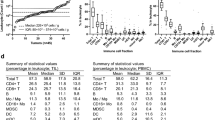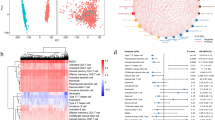Abstract
Malignant effusions and tumour tissue obtained at surgery provided material for a study of the prognostic value of the various inflammatory cells in the prognosis of human ovarian cancer. Ascitic fluids predominantly contained inflammatory cells, tumour cells, both singly and in clusters, were a minor component. Tumour cells were usually in excess in dispersed solid material. Some patients had significant proportions of lymphocytes and macrophages in their solid tumour, and these patients invariably responded to therapy. Sedimentation-velocity separation at unit gravity provided tow populations of inflammatory cells. One consisted of mononuclear cells similar in size to those in the patients blood: the other consisted of one or more large macrophage populations, distinct in morphology and enzymatic markers from both blood monocytes and each other. T lymphocytes were enriched in ascites fractions (78%) and in the tumour-derived mononuclear fraction (71%) compared to patient blood (60%). The T-cell subset characterized by ANAE reactivity was markedly depleted in the tumour-infiltrating fraction (17%) compared to patient blood (62%) or patient blood (51%). Esterase-positive monocyte-like cells were more frequent in the tumour-infiltrating fraction (17%) than ascites (7%) or blood (12%). B lymphocytes were infrequent in solid tumours and difficult to assess in ascites. Histiocyte-like macrophages were present in the higher-velocity tumour-cell containing fractions of both solid and ascitic material. The variation in infiltrating cells between patients and between tumour and ascites of the same individual was marked.
This is a preview of subscription content, access via your institution
Access options
Subscribe to this journal
Receive 24 print issues and online access
$259.00 per year
only $10.79 per issue
Buy this article
- Purchase on Springer Link
- Instant access to full article PDF
Prices may be subject to local taxes which are calculated during checkout
Similar content being viewed by others
Rights and permissions
About this article
Cite this article
Haskill, S., Becker, S., Fowler, W. et al. Mononuclear-cell infiltration in ovarian cancer. I. Inflammatory-cell infiltrates from tumour and ascites material. Br J Cancer 45, 728–736 (1982). https://doi.org/10.1038/bjc.1982.114
Issue Date:
DOI: https://doi.org/10.1038/bjc.1982.114
This article is cited by
-
A history of exploring cancer in context
Nature Reviews Cancer (2018)
-
RETRACTED ARTICLE: Targeted immune therapy of ovarian cancer
Cancer and Metastasis Reviews (2015)
-
Toll-like receptor expression in normal ovary and ovarian tumors
Cancer Immunology, Immunotherapy (2009)
-
The Tumor Microenvironment: The Making of a Paradigm
Cancer Microenvironment (2009)
-
Immunological profiling of a panel of human ovarian cancer cell lines
Cancer Immunology, Immunotherapy (2008)



